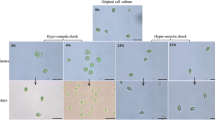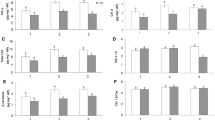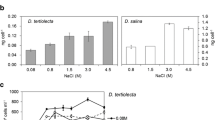Abstract
Changes in glycerol content are reported for Dunaliella tertiolecta over an 8 h period after a salt stress or dilution stress. Under the experimental conditions, the new glycerol level was reached in about 30 min in light or dark but there was evidence of oscillations after that, particularly on dilution stress. Glycerol disappearance on dilution stress is caused predominantly by dissimilation. A salt stress immediately inhibited photosynthetic oxygen evolution and caused net oxygen uptake for a period of about 36 h after the stress. Oxygen evolution was reestablished after that and the process of recovery to the point of resumption of net evolution was not affected by conditions designed to inhibit protein synthesis. Dilution stress of comparable magnitude diminished but did not eliminate photosynthetic oxygen evolution and recovery to a pre-stress level took about 18 h. Effects of HCO -3 concentration suggested that photorespiration was not the sole determinant of oxygen uptake induced by salt stress but it was not possible to apportion with confidence the contribution of mitochondrial and other types of respiration. There was no evidence that modification by stress of energy-induced proton fluxes across the plasma membrane constituted an osmoregulatory signal in either species.
Similar content being viewed by others
References
Ben-Amotz A (1975) Adaptation of the unicellular alga Dunaliella parva to a saline environment. J Phycol 11:50–54
Borowitzka LJ, Brown AD (1974) The salt relations of marine and halophilic species of the unicellular green alga, Dunaliella. The role of glycerol as a compatible solute. Arch Microbiol 96:37–52
Borowitzka LJ, Kessly DS, Brown AD (1977) The salt relations of Dunaliella. Further observations on glycerol production and its regulation. Arch Microbiol 113:131–138
Brown AD (1979) Physiological problems of water stress. In: Shilo M (ed) Strategies of microbial life in extreme environments. Dahlem Konferenzen Berlin, pp 65–81
Brown AD, Borowitzka LJ (1979) Halotolerance of Dunaliella. In: Levandowsky M, Hutner SH (eds) Biochemistry and physiology of protozoa, Vol 1. Academic Press, New York, pp 139–190
Brown AD, Edgley ME (1980) Osmoregulation in yeast. In: Rains DW, Valentine RC, Hollaender A (eds) The genetic engineering of osmoregulation. Plenum Press, New York, pp 75–90
Delieu T, Walker DA (1972) An improved cathode for the measurement of photosynthetic oxygen evolution by isolated chloroplasts. New Phytol 71:201–225
Hellebust JA (1976) Osmoregulation. Ann Rev Plant Physiol 27:485–505
Kauss H (1977) Biochemistry of osmotic regulation. Intern Rev Biochem Plant Biochem II 13:119–140
Lowry OH, Rosebrough MJ, Farr AL, Randall RJ (1951) Protein measurement with the Folin phenol reagent. J Biol Chem 193:265–275
Walker DA (1971) Chloroplasts (and grana): aqueous (including high carbon fixation ability). In: San Pietro A (ed), Methods in Enzymology 23: 211–220
Author information
Authors and Affiliations
Rights and permissions
About this article
Cite this article
Kessly, D.S., Brown, A.D. Salt relations of Dunaliella. Transitional changes in glycerol content and oxygen exchange reactions on water stress. Arch. Microbiol. 129, 154–159 (1981). https://doi.org/10.1007/BF00455353
Received:
Accepted:
Issue Date:
DOI: https://doi.org/10.1007/BF00455353




